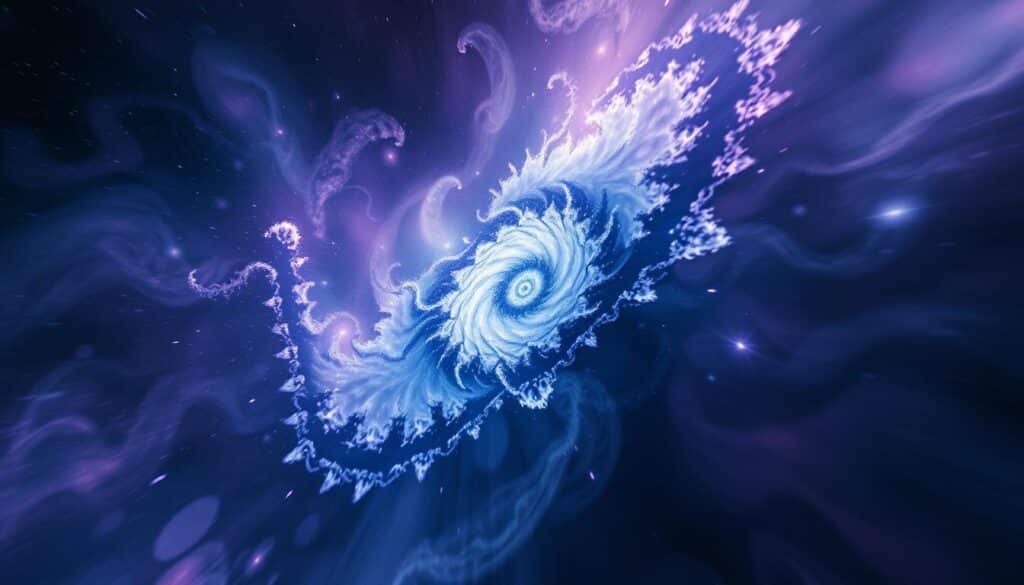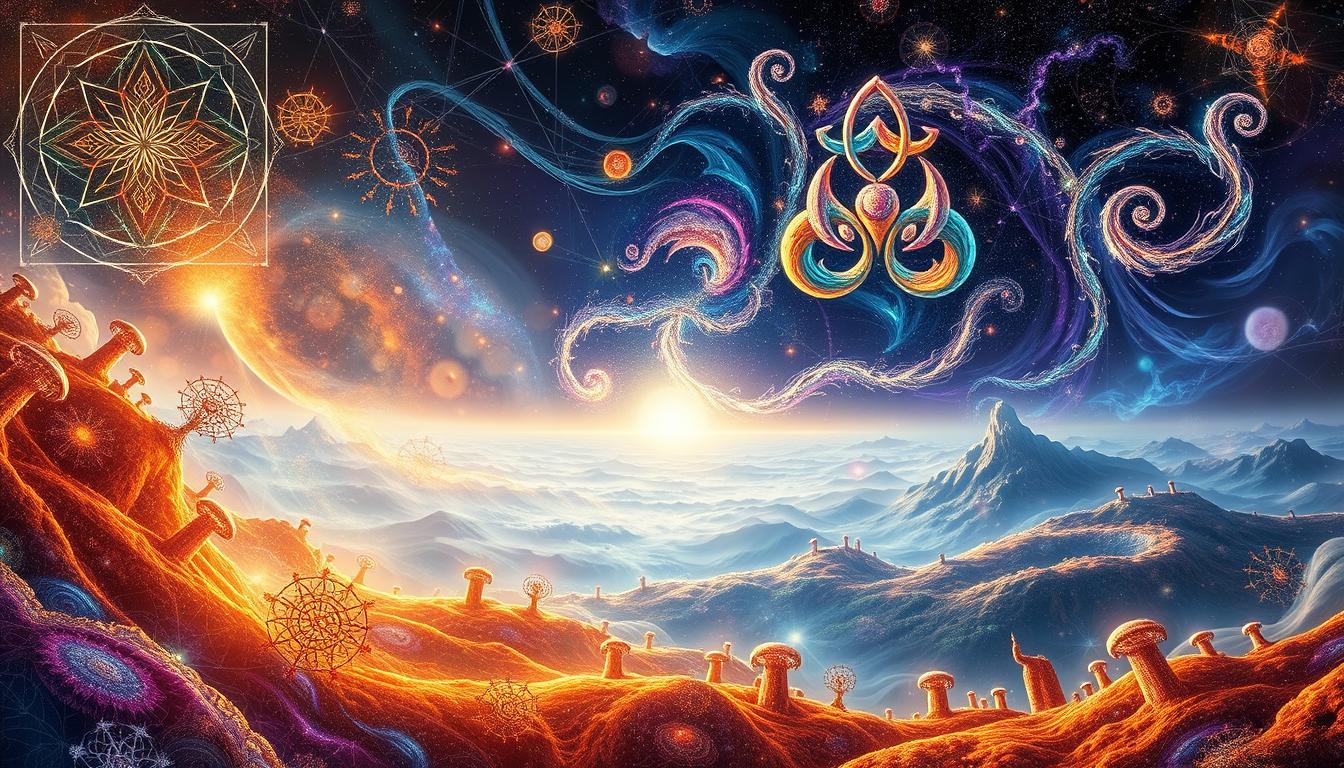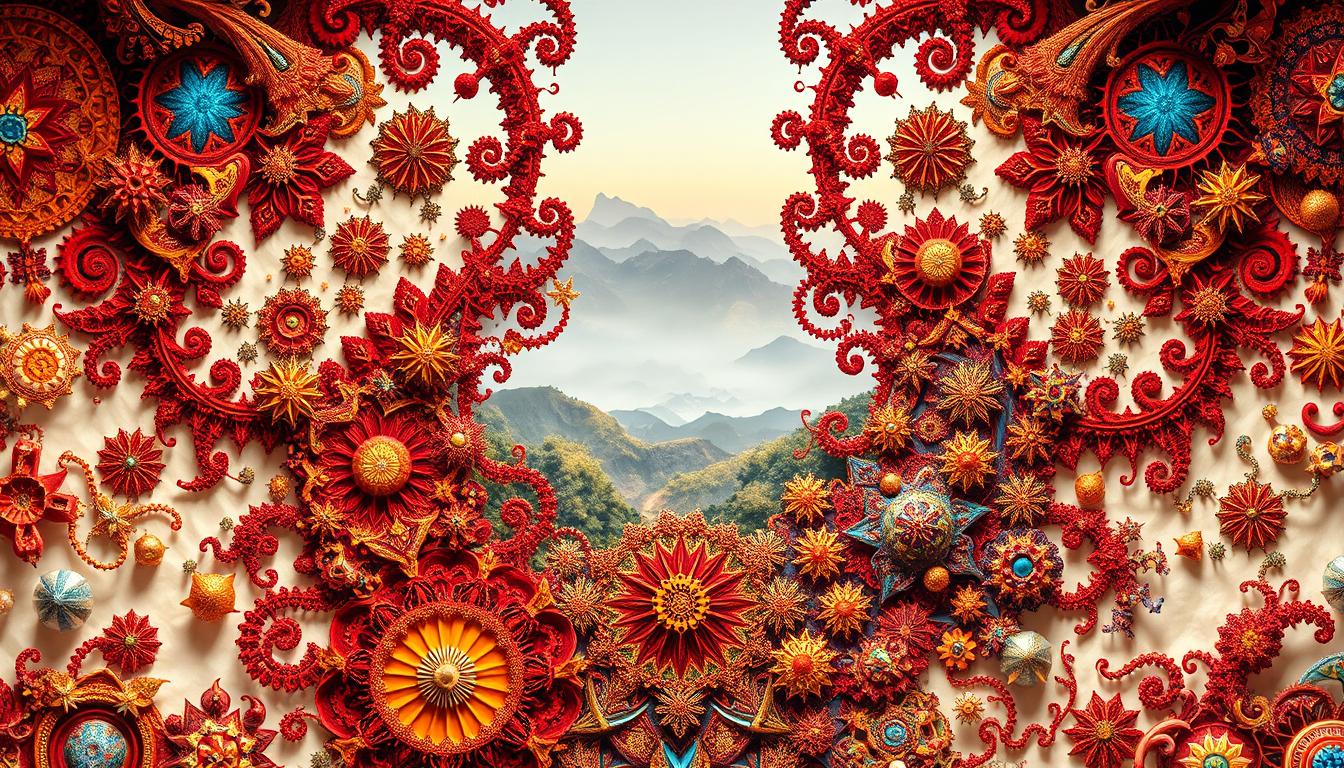The cosmic fractal idea shows us the universe is full of complex, repeating patterns. These patterns show up in different sizes. In this article, we dive deep into the fractal universe theory. It highlights how the patterns in the universe reveal self-similarity in the massive universal structure.
By looking at math models and space observations, we learn about the fractals in our universe’s design. This makes us see the universe in a new way.
Introduction to the Cosmic Fractal
The idea that our universe is filled with repeating patterns is both fascinating and complex. These patterns appear at different sizes, showing the structured yet chaotic nature of the cosmos. An overview of fractal theory shows that nature is full of these patterns, giving order to what seems random.
This theory makes us wonder about the patterns we see. Are they just random, or do they mean something more in the vast universe? By studying the cosmic fractal, we start to think about our role in the universe. It leads us to explore how we connect with everything around us.

What Are Fractals?
Fractals are complex shapes that repeat patterns at different sizes. They are both visually and mathematically fascinating. They offer deep insight into their structure. Fractals are self-similar, meaning parts of them look like the whole thing.
Examples like snowflakes and tree branches show this. Smaller pieces of these objects mirror the larger structure.
Understanding Self-Similarity in Fractals
Self-similarity is a key feature of fractals. It means smaller parts have the same shape as the entire object. Snowflakes are a perfect example, where each arm looks like the whole snowflake.
Other examples include ferns and rivers. They show repeating patterns found in nature and math.
The Mathematical Backbone of Fractals
Fractals are different from regular shapes because of their math properties. Unlike circles and squares with whole dimensions, fractals have fractional ones. This shows their complexity and endless detail.
Benoit Mandelbrot introduced fractal geometry. He showed how fractals make us rethink space and dimension.
The Observable Universe and Patterns
The observable universe shows us fascinating cosmic patterns. Researchers explore vast space regions to learn about it. They find the galaxy distribution forms a complex “cosmic web.”
This cosmic web has various structures like clusters and superclusters, and big empty spaces. These shapes look like fractals, with similar patterns on different sizes. This shows us how galaxies spread out and teaches us about the universe’s structure.
Tools like the Hubble Space Telescope help us see this detailed setup. Studies show galaxies are arranged in special ways. They form patterns that make us rethink how we see the universe.
The Cosmic Fractal: How the Universe Repeats Its Patterns
The universe is full of amazing cosmic fractal patterns. You can see this in how galaxies are structured and the big cosmic web. These patterns show us that the same features repeat on different scales. It highlights the fractal nature of the universe.
Patterns in the Structure of Galaxies
Galaxies have a consistent pattern in their structure. Big clusters are made of smaller groupings, reflecting fractal geometry’s features. This layout implies that galaxies are closely linked, not just scattered random bits. Their similarity in shape and setup, no matter the scale, proves the universe’s repeating patterns.
The Cosmic Web and Its Fractal Nature
The cosmic web is an awe-inspiring show of fractal principles in space. It stretches over billions of light-years. This galaxy network, with its intricate nodes and filaments, showcases fractal traits. We see that matter forms repeating patterns over huge distances. The cosmic web is a vast example of the universe’s fractal patterns.
Scientific Evidence Supporting the Fractal Universe Theory
The fractal universe theory is backed by scientific studies and math models. These studies show it’s important in cosmology. Patterns seen in the universe’s huge structure point to a fractal nature.
This idea is supported by math theories and the impact of gravitational collapse in the cosmos.
Mathematical Models and Their Implications
Math models are key in backing the fractal universe theory. These models show galaxy formations that look like fractals. The important findings include:
- Evidence of large-scale clustering in galaxy distributions.
- Discoveries of self-similar patterns across different cosmic scales.
- The ability to predict cosmic structures based on mathematical correlations.
The Role of Gravitational Collapse in Structure Formation
Gravitational collapse is crucial in forming structures in the universe, supporting the fractal theory. When space material collapses under gravity, it forms structures with fractal traits. Observations show:
- Formation of stars and galaxies through gravitational dynamics.
- Emergence of larger structures, like galaxy clusters and superclusters.
- The consistent yield of fractal patterns throughout various cosmic scales.
Arguments Against the Fractal Universe
Critics of the fractal universe come from many areas of study. They point out big issues with using fractal theory to describe space. They say fractality might not work on the vast scales of the cosmos. This could go against the idea that the universe is similar everywhere.
The idea behind fractals is they can be split up endlessly and always look the same, no matter the scale. But the actual cosmic structures are more complex. They show the universe isn’t infinite, so it might not fit into fractal patterns.
These criticisms make people doubt if the fractal universe can really reflect all of space. The flaws of fractal theory are clear when we think about how the real universe works. It doesn’t match the perfect theory drawn up by cosmologists.
Philosophical Implications of a Fractal Universe
Thinking of a fractal universe brings up big questions that make us rethink what we know. This idea means the universe is made of repeating patterns at different sizes. It makes us wonder about our existence, time, and how everything is built.
Impacts on Concepts of Infinity and Determinism
A fractal universe suggests endless repeating structures, sparking thoughts on infinity. This endless cycle makes us question what existence really means. Thinking about infinity could change how we see major cosmic events and their importance.
This idea also touches on the debate about whether everything is predetermined. If similar patterns repeat on many levels, we might question if we have free will. It hints that predetermined patterns might shape reality, affecting our choices and futures. Philosophies from old to new have wrestled with this balance between fate and free choice.
Social Commentary: Our Fractal Society
The concept of a fractal society helps us look closely at our social patterns. Like the universe with its repeating shapes, our societies show similar patterns, especially in how money and power are organized.
Fractal Patterns in Economic Structures
Economic structures show fractal patterns too. The way wealth is spread out often shows big inequalities, much like fractals. A tiny part of the population controls a massive share of resources. This mirrors how wealth is concentrated, similar to vast cosmic structures.
- The top 1% controls a lot of the world’s wealth, showing fractal growth patterns.
- Mid-tier economic groups have their own inequalities, reflecting the layered nature of fractals.
- Market changes often happen in repeating cycles, helping us understand how economies work.
Hierarchical Structures in Organizations
Organizations show fractal traits in their hierarchies too. Companies have layers of management that reflect broader social power patterns. This shows how authority works at different levels.
- Companies often have several layers of management, mirroring the top-level decisions.
- Decision-making can be seen repeating from small teams to the whole company.
- The way organizations react to outside pressures can mirror natural fractal patterns.
Future Research Directions in Fractal Cosmology
Fractal cosmology has many exciting paths for future research. New technology in observing the universe will help us learn more about its structures. Advanced telescopes and imaging methods will let scientists get better data on how galaxies and cosmic events are spread out.
This will lead to new discoveries about the universe’s structure. One important area is studying Fundamental Density Theory (FDT). This theory could show us how cosmic structures are organized and move. Scientists want to understand how similar patterns repeat across different scales.
They aim to connect math models with real-world observations. Also, looking deeper into fractal cosmology might mean rethinking old ideas. By adding new theories and improving current ones, researchers hope to get a fuller picture of how the universe is put together. This work will push forward not just fractal cosmology, but also the wider field of astrophysics.
Conclusion
The journey through the fractal universe shows us a world filled with mesmerizing patterns that spark wonder and questions. We’ve looked at how these patterns appear everywhere, from tiny atoms to huge galaxies. But, there’s still a lot we don’t know. The idea of a fractal universe makes us think and be careful as we learn more about these amazing patterns.
Fractal designs in nature show us beauty that’s hard to believe. They lead us on an exciting path of discovery. This journey makes scientists and curious minds eager to learn more about these patterns. They want to understand how they come to be. This mix of art and science makes us see the universe in a new way.
Thinking about the fractal universe reminds us that there’s so much more to learn. It pushes us to explore more, bringing new ideas and better understanding of our place in the universe. Exploring this fractal world is both a science project and a deep dive into what makes everything. It’s about finding the connection between structure, beauty, and the things we don’t yet know.



